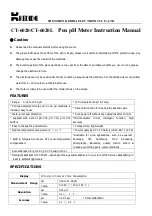
SDA Operator’s Manual
SDA-OM-E Rev H
379
A smaller data set is extrapolated in order to estimate the data for the larger sample size. The
extrapolation of the measured histogram of TIE values uses the random nature of jitter at the
extremes of the histogram to extrapolate the bins below the 10th percentile and above the 90th
percentile. The central part of the distribution is dominated by deterministic jitter, while the
extremes are entirely random. The bins in these ranges behave as a normal distribution as the
jitter range is increased, that is, their populations fall as exp(-t2). Taking the logarithm of the
histogram makes this relationship quadratic, so the extrapolation is simply a quadratic curve fit to
the extremes of the log of the jitter histogram. The extrapolated histogram is used to compute the
total jitter curve described above and is normalized so that the sum of the populations of all of the
bins is one. The integrals described above are implemented by summing the extrapolated
histogram bins.
Separating Rj and Dj – Two Methods
The total jitter curve is the basis for estimating the magnitude of Rj and Dj. Since the total jitter
curve is derived directly from the signal under test, its value is the most accurate representation
of the jitter for a given bit error rate. There are basically two ways of separating the random and
deterministic jitter. The first method, which models the growth of total jitter as BER is decreased,
leads to the effective jitter parameters Rje and Dje. These values are effective in the sense that
they provide an equivalent total jitter model for low bit error rates. Starting with the total jitter
curve, the growth in the total jitter as a function of decreasing BER is plotted. The curve described
by equation 1 is fitted to the measured curve by selecting the Rj (slope) and Dj (intercept) to
minimize the error in the fit.
The second method of fitting Rj and Dj to the measured data is based on direct measurements of
the deterministic jitter. Random jitter is the difference between this value and the total jitter at the
selected bit error rate measured from the total jitter curve. This, of course, exactly matches the
measured total jitter at the selected bit error rate, but is a poor predictor of the jitter for bit error
rates below this level. The motivation behind employing this method is to better represent the
contribution of deterministic jitter in the overall jitter at the specified bit error rate.
Each method of measuring Rj and Dj results in different values for the standard deviation and
spacing between the Gaussian curves in the distribution in Figure 7. The total jitter at the
specified bit error rate, however, is the same for either distribution.
Effective Random and Deterministic Jitter
The effective jitter components Rje and Dje represent the best fit values for equation 1 to the
behavior of the measured total jitter as the observation time is increased or, equivalently, the bit
error rate is decreased. For a given bit error rate, the total jitter is measured from the width of the
total jitter curve. The value of the total jitter as the bit error rate is decreased can be plotted as
shown in Figure 13. The vertical axis of the plot on the left is the log of bit error rate. The
Gaussian nature of the jitter at the extremes of the distribution results in a total jitter that grows
approximately linearly with the log of BER, as shown in the upper curve in the plot on the right.
The function N(BER)in equation 1 represents the width of a normal distribution with a variance of
one at a given confidence level equal to 1-BER. The lower curve on the plot on the right shows
the variation of N(BER) with the log of BER which is approximately linear. The values of Rje and
Dje are chosen so that the lower curve lies on top of the upper one. From equation 1, it can be
seen that Rje is a slope parameter while Dje adjusts the intercept point.
Содержание SDA
Страница 1: ...SERIAL DATA ANALYZER OPERATOR S MANUAL December 2007 ...
Страница 148: ...Standard Horizontal Parameter Help Markers Standard Vertical Parameter Help Markers 148 SDA OM E Rev H ...
Страница 223: ...SDA Operator s Manual Example 6 SDA OM E Rev H 223 ...
Страница 225: ...SDA Operator s Manual SDA OM E Rev H 225 ...
Страница 232: ...In this figure the panel has been pasted onto the Excel sheet for comparison 232 SDA OM E Rev H ...
Страница 243: ...SDA Operator s Manual This example used the CORREL Array1 Array2 function of Excel as depicted below SDA OM E Rev H 243 ...
Страница 246: ...246 SDA OM E Rev H ...
Страница 247: ...SDA Operator s Manual Excel Example 5 Using a Surface Plot SDA OM E Rev H 247 ...
Страница 279: ...SDA Operator s Manual Convolving two signals SDA OM E Rev H 279 ...
Страница 310: ...The jitter wizard is accessed from the Analysis drop down menu 310 SDA OM E Rev H ...
Страница 327: ...SDA Operator s Manual SDA OM E Rev H 327 ...
Страница 328: ...328 SDA OM E Rev H ...
Страница 394: ...394 SDA OM E Rev H ...
Страница 395: ...SDA Operator s Manual SDA OM E Rev H 395 ...
















































